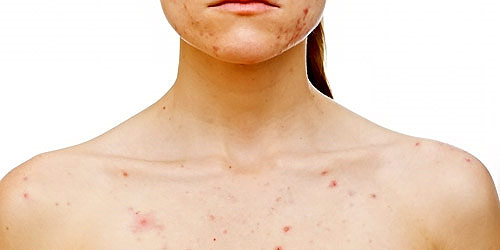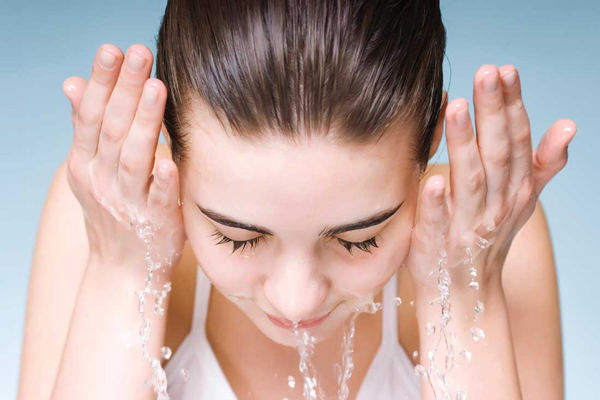
Acne is a disease that nearly all of us have had to deal with at sometime or another in our lives. Nearly 17 million people in the United States have acne, making it the most common skin disease. Acne is a common, self-limiting, multifactorial disease involving the sebaceous (oil producing) follicles of the face and upper trunk. Acne affects approximately 85% of the population between the ages of 12 and 25. Most teens that get acne have the milder form, called non-inflammatory acne, and get just a few blackheads or whiteheads every now and then. But some people suffer from the more severe form, called inflammatory acne, and have a constant outbreak covering the face, and sometimes also the neck, back, chest, and groin. In the United States, at least 350,000 patients have acne severe enough to require treatment. Although acne is generally self-limiting and non-life-threatening, the psychological effect it can have on patients is profound. This is reflected in the amount of money spent on acne therapy in the United States each year. Sales of nonprescription acne medications exceed $100 million annually; with hundreds of millions of additional dollars spent on prescription acne medications.
Pathophysiology of Acne
The causes of acne are multifactorial and not completely understood. Theories on the causes of acne include the role of androgens (hormones), Propionibacterium acnes, sebum production, and follicle growth. Each of these specific theories will be discussed in further detail once we have reviewed the basic pathophysiology of acne.
Acne is generally limited to the parts of the body that have the largest and most abundant sebaceous glands – the face, neck, chest, upper back, and upper arms. These sebaceous glands normally produce sebum, a substance which moisturizes the skin. Acne lesions are typically centered about the pilosebaceous follicles, which open onto the skin surface as the pores of the skin.
Sebaceous glands develop at puberty in response to androgen stimulation and are attached to the follicle canal by sebaceous ducts. Acne is believed to result from a change in the inner lining of the follicle that prevents sebum from passing through. For reasons not completely understood, cells from the lining of the follicle are shed too fast and clump together. The clumped cells plug up the follicle’s opening so sebum cannot reach the surface of the skin. One of the jobs of the sebum is to carry cells shed by the glands to the surface of the skin. But because the excess sebum is blocking the openings of the glands, called ducts, both cells and sebum accumulate. This mixture of oil and cells causes bacteria that normally live on the skin, called Propionibacterium acnes (P. acnes), to grow in the plugged follicles.
These bacteria produce chemicals and enzymes that cause inflammation, which is a characteristic reaction of tissues to injury and is marked by four signs: swelling, redness, heat, and pain.
When the plugged follicle can no longer hold its contents, it bursts and spills everything onto the nearby skin – sebum, shed skin cells, and bacteria. Lesions or pimples develop as a result of the skin’s being irritated.
Individuals with acne may have a variety of lesions. The basic acne lesion, called the comedo (kom¢-e-do), is simply an enlarged hair follicle plugged with oil and bacteria. This lesion is often referred to as a microcomedo because it cannot be seen by the naked eye.
If the plugged follicle, or comedo, stays beneath the skin, it is called a closed comedo or whitehead. Whiteheads usually appear on the skin as small, whitish bumps. A comedo that reaches the surface of the skin and opens up is called a blackhead because it looks black on the skin’s surface. This black discoloration is not due to dirt but rather to the oxidation of melanin pigment. Both whiteheads and blackheads may stay in the skin for a long time.
Other acne lesions which can develop, include the following:
Papules – inflamed lesions that usually appear as small, pink bumps on the skin and can be tender to the touch
Pustules (pimples) – inflamed, pus-filled lesions that can be red at the base
Nodules – large, painful, solid lesions that are lodged deep within the skin
Cysts – deep, inflamed, pus-filled lesions that can cause pain and scarring
ACNE CAUSES
The exact cause of acne is unknown, but physicians believe it results from several related factors.
Potential causes include:
- role of androgens (hormones)
- Propionibacterium acnes (P. acnes)
- sebum production
- follicle growth
Role of Androgens
Androgens (male sex hormones) stimulate growth of sebaceous follicles and enhance production of sebum. After puberty, boys produce 10 times as much androgen as girls; therefore it is not surprising that more boys than girls develop severe cases of acne. During the second decade of life, sebum production closely parallels both androgen production and the presence of acne. Although testosterone is the most potent androgen, its metabolites and weaker androgens are increased in acne patients and may stimulate sebaceous gland activity.
Sebum Production
Sebum is produced in the sebaceous glands and consists of glycerides, wax esters, squalene, and cholesterol. At times, a relationship between increased sebum secretion and severity of acne is present. The glyceride component of sebum is converted to free fatty acids (FFA) and glycerol by lipases, products of P. acnes. FFA may irritate the follicular wall and cause increased cell turnover and inflammation.
Follicle Growth
Abnormal alterations in the follicle wall and its cell growth (keratinization) have also been associated with acne. The increased production of loosely adherent keratin cells has been correlated with obstruction of the follicles seen in comedo formation. Whether this abnormality is inherent or secondary to other factors is unknown.
Bacteria
P. acnes is part of the normal flora in the sebaceous follicle and plays an important role in the initial development and maintenance of the inflammatory response present in acne.
Although P. acnes counts are typically higher in patients with acne, and antibiotic therapy reduces these count, the pathogenic role of P. acnes is not that of simple infection. P. acnes may be capable of causing increased antibody formation, thereby leading to an inflammatory response. Although the exact cause of acne is unclear, its pathogenesis involves many factors that are interrelated.
Other Potential Causes
Hormonal changes related to pregnancy or starting/stopping birth control pills can also cause acne. Stress, particularly severe or prolonged emotional tension, may aggravate acne. Certain drugs, including androgens, lithium, and barbiturates are known to cause acne. Greasy cosmetics may alter the cells of the follicles and make them stick together. Friction caused by leaning on or rubbing the skin or the pressure of bike helmets, backpacks, or tight collars can contribute to or worsen acne. Also, environmental irritants (such as pollution and high humidity), squeezing or picking at blemishes, and hard scrubbing of the skin can make acne worse.
Acne Myths
In addition to the potential causes of acne, there are also many myths about what causes acne. Chocolate and greasy foods are often blamed, but research has shown that foods seem to have little effect on the development and course of acne in most people. Another myth is that dirty skin causes acne; however, blackheads and other forms of acne lesions are not caused by dirt.

Key Article Points:
Acne is the most common skin disease in the U.S., affecting approximately 85% of the population between the ages of 12 and 25
Acne is thought to be, in part, the result of oil glands at the base of the hair follicles which become overactive during teenage years as a result of hormonal changes
Causes of acne are multifactorial and include: role of androgens, P. acnes, sebum production, follicle growth
Skin cells can “plug” skin pores causing whiteheads, which stay below the skin and blackheads, with reach the skin surface
A “pimple” is an oil gland that is infected with bacteria, resulting in an inflamed area with pus formation
Acne is NOT caused by eating oily foods, soda, or chocolate

What Do You Think? Leave A Comment!